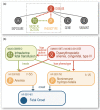Prenatal phenotyping: A community effort to enhance the Human Phenotype Ontology
- PMID: 35872606
- PMCID: PMC9588534
- DOI: 10.1002/ajmg.c.31989
Prenatal phenotyping: A community effort to enhance the Human Phenotype Ontology
Abstract
Technological advances in both genome sequencing and prenatal imaging are increasing our ability to accurately recognize and diagnose Mendelian conditions prenatally. Phenotype-driven early genetic diagnosis of fetal genetic disease can help to strategize treatment options and clinical preventive measures during the perinatal period, to plan in utero therapies, and to inform parental decision-making. Fetal phenotypes of genetic diseases are often unique and at present are not well understood; more comprehensive knowledge about prenatal phenotypes and computational resources have an enormous potential to improve diagnostics and translational research. The Human Phenotype Ontology (HPO) has been widely used to support diagnostics and translational research in human genetics. To better support prenatal usage, the HPO consortium conducted a series of workshops with a group of domain experts in a variety of medical specialties, diagnostic techniques, as well as diseases and phenotypes related to prenatal medicine, including perinatal pathology, musculoskeletal anomalies, neurology, medical genetics, hydrops fetalis, craniofacial malformations, cardiology, neonatal-perinatal medicine, fetal medicine, placental pathology, prenatal imaging, and bioinformatics. We expanded the representation of prenatal phenotypes in HPO by adding 95 new phenotype terms under the Abnormality of prenatal development or birth (HP:0001197) grouping term, and revised definitions, synonyms, and disease annotations for most of the 152 terms that existed before the beginning of this effort. The expansion of prenatal phenotypes in HPO will support phenotype-driven prenatal exome and genome sequencing for precision genetic diagnostics of rare diseases to support prenatal care.
Keywords: GA4GH Phenopacket; HPO; fetal pathology; human phenotype ontology; prenatal diagnosis; prenatal phenotyping.
© 2022 The Authors. American Journal of Medical Genetics Part C: Seminars in Medical Genetics published by Wiley Periodicals LLC.
Figures



References
-
- Biesecker, L. G. (2004). Phenotype matters. Nature Genetics, 36, 323–324. - PubMed
Publication types
MeSH terms
Grants and funding
LinkOut - more resources
Full Text Sources
Research Materials
Miscellaneous

